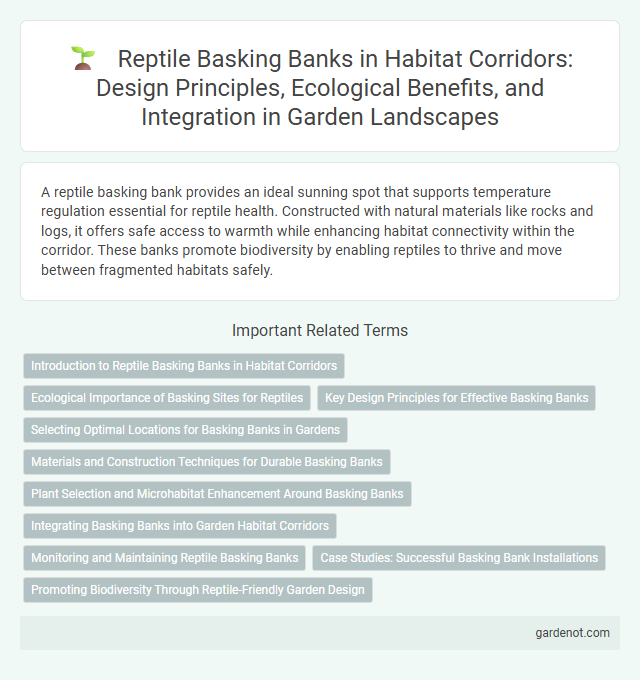A reptile basking bank provides an ideal sunning spot that supports temperature regulation essential for reptile health. Constructed with natural materials like rocks and logs, it offers safe access to warmth while enhancing habitat connectivity within the corridor. These banks promote biodiversity by enabling reptiles to thrive and move between fragmented habitats safely.
Introduction to Reptile Basking Banks in Habitat Corridors
Reptile basking banks serve as critical microhabitats within habitat corridors, providing essential heat sources for thermoregulation and enhancing species survival. These banks, typically composed of sun-exposed soil or rock substrates, facilitate optimal body temperature regulation for reptiles such as lizards and snakes, promoting activity and digestion. Integrating reptile basking banks into habitat corridors supports biodiversity by enabling movement and connectivity between fragmented habitats.
Ecological Importance of Basking Sites for Reptiles
Reptile basking banks serve as critical microhabitats that regulate thermoregulation by providing optimal sunlight exposure necessary for metabolic processes. These sites support biodiversity by offering safe environments for reptiles to absorb heat, crucial for digestion, immune function, and reproductive success. Maintaining habitat corridors with intact basking banks ensures connectivity and stability of reptile populations within fragmented landscapes.
Key Design Principles for Effective Basking Banks
Effective reptile basking banks prioritize south-facing exposure to maximize solar radiation for thermoregulation. Use of varied substrate textures and rock sizes creates diverse microhabitats, supporting different species and age groups. Incorporating gentle slopes and sheltered areas minimizes predation risk while facilitating easy access and egress for reptiles.
Selecting Optimal Locations for Basking Banks in Gardens
Selecting optimal locations for reptile basking banks in gardens involves identifying sunny, well-drained areas that receive ample direct sunlight throughout the day. Proximity to natural shelters like hedges, logs, and rocks enhances safety and encourages reptile use by providing quick refuge options. Incorporating varied substrates such as sand, gravel, or flat stones on the basking bank ensures temperature regulation and mimics natural conditions, promoting effective thermoregulation for diverse reptile species.
Materials and Construction Techniques for Durable Basking Banks
Reptile basking banks utilize materials such as natural stone, durable timber, and heat-retentive concrete to create stable, long-lasting surfaces ideal for thermoregulation. Construction techniques emphasize layering substrates like sand and gravel beneath hardscaping to ensure both drainage and structural integrity. Incorporating UV-resistant sealants and modular designs enhances weather resistance and allows easy maintenance for sustained habitat functionality.
Plant Selection and Microhabitat Enhancement Around Basking Banks
Selecting native, sun-loving plant species such as grasses, sedges, and low shrubs around reptile basking banks creates shelter and supports thermoregulation by providing shaded retreats. Incorporating diverse vegetation enhances microhabitat complexity, offering humidity gradients and protection from predators. Strategic placement of plants near basking sites helps maintain optimal temperature zones critical for reptile health and activity within habitat corridors.
Integrating Basking Banks into Garden Habitat Corridors
Integrating reptile basking banks into garden habitat corridors enhances thermoregulation opportunities essential for species like lizards and snakes by providing elevated sunlit spots. Constructed from natural stone or wood, these basking banks support biodiversity by connecting fragmented habitats and facilitating safe movement. Optimizing placement along migratory routes within the corridor maximizes reptile population resilience and ecosystem health.
Monitoring and Maintaining Reptile Basking Banks
Regular monitoring of reptile basking banks involves tracking temperature variations and habitat usage to ensure optimal conditions for thermoregulation. Maintenance activities include clearing vegetation overgrowth and managing soil moisture levels to preserve basking surface quality. Implementing adaptive management based on species-specific behavior supports the long-term viability of reptile populations in habitat corridors.
Case Studies: Successful Basking Bank Installations
Successful reptile basking bank installations have demonstrated significant improvements in local species' thermoregulation and breeding success. Case studies from the UK and Australia reveal that carefully engineered banks with varied slopes and substrate types encourage prolonged basking periods and increase overall habitat connectivity. Monitoring data shows these installations lead to higher reptile population densities and enhanced survival rates.
Promoting Biodiversity Through Reptile-Friendly Garden Design
Creating a reptile basking bank within habitat corridors enhances microhabitats crucial for thermoregulation and species survival. Incorporating native vegetation and varied sun exposure supports diverse reptile communities, fostering ecological balance. Designing with reptile needs in mind boosts biodiversity and aids in sustaining local ecosystems.
Reptile basking bank Infographic

 gardenot.com
gardenot.com